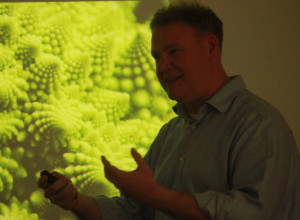Autumn Simms, Lion’s Eye Staff Writer, als6765@psu.edu
Putting aside their fears of reptiles, students at Penn State Brandywine got to interact with various reptiles deep within the Lion’s Den. Keith Gisser, founder of the HERPS ALIVE!! program, brought creatures of varying sizes and intimidation levels for students to learn about.
Gisser has over thirty years of experience handling reptiles and amphibians. Since 1990, HERPS ALIVE!! has been traveling to 250 colleges in 36 states educating students on reptiles in a fun interactive way. They have been to Villanova University, Temple University and Delaware Valley College to name a few places.
Students like, Antonio Nicosia, got to pet one of four tortoises.
Nicosia said, “They’re pretty awesome. This stands out to me as a semester highlight.”Several students volunteered to be draped with an eight foot five inch Albino Burmese Python named Silas. Silas weighed 40 pounds. A student, named Ameer, described the snake as “super soft, exciting, and slippery.”
Bridget O’Donnell, assistant director of student affairs, said the event was, “Educational-something different for the students.”
While assisting Gisser and O’Donnell with the python, student helper, Vince Dejohn, said, “This is something I want to do for a living.”
There were skinks (a type of lizard), corn snakes, a baby alligator, a bearded dragon and an Asian Water Monitor. All the cold-blooded reptiles appeared extremely friendly and comfortable being in the hands of curious Penn State students.
There was a 5-foot, 10-year-old Asian Water Monitor named Gator, weighing 25 pounds. Gator nestled herself like a baby on students’ shoulders.
Jake Fida said, “It was fulfilling to hold a very large lizard.” He wasn’t the only one who felt this way.
Keith Gisser is also the executive director of the non-profit Herps Alive Foundation started in 2013 and dedicated to rescuing neglected and/or abused reptiles and amphibians. The volunteers of the Herps Alive Foundation rehabilitate these animals and provide a sanctuary for them until they find a new home. They emphasize the importance of educating the public about reptiles and amphibians.
Herps Alive Foundation is a member of the Northern Ohio Association of Herpetologist, U.S Association of Reptile Keepers and Zoological Association of America. They have their own website at gggreg.com/herps_alive.html and a Facebook page at Herps Alive.
